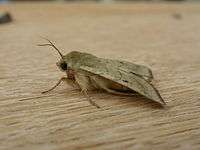Helicoverpa armigera
| Cotton bollworm | |
|---|---|
 | |
| Helicoverpa armigera | |
 | |
| Scientific classification | |
| Kingdom: | Animalia |
| Phylum: | Arthropoda |
| Class: | Insecta |
| Order: | Lepidoptera |
| Family: | Noctuidae |
| Genus: | Helicoverpa |
| Species: | H. armigera |
| Binomial name | |
| Helicoverpa armigera (Hübner, [1809]) | |
| Synonyms | |
| |
The cotton bollworm, corn earworm or Old World (African) bollworm, Helicoverpa armigera,[1] (also known as the scarce bordered straw in the UK, where it is an immigrant[2]) is a moth, the larvae of which feed on a wide range of plants, including many important cultivated crops. It is a major pest in cotton and one of the most polyphagous and cosmopolitan pest species. It should not be confused with the similarly named, related species Helicoverpa zea.
Distribution
This species is widespread in central and southern Europe, temperate Asia, Africa, Australia and Oceania, and has also recently been confirmed to have successfully invaded Brazil.[3] It is a migrant species, able to reach Scandinavia and other northern territories.[4]
Morphology



The cotton bollworm is very variable in both size and colour. The body length varies between 12 millimetres (0.47 in) and 20 millimetres (0.79 in) with a wingspan of 30–40 millimetres (1.2–1.6 in). The forewings are yellowish to orange in females and greenish-gray in males, with a slightly darker transversal band in the distal third.[5] The external transversal and submarginal lines and the reniform spot are diffused. The hind wings are a pale yellow with a narrow brown band at the external edge and a dark round spot in the middle.[4]
Life cycle


The female cotton bollworm can lay several hundred eggs, distributed on various parts of the plant. Under favourable conditions, the eggs can hatch into larvae within three days and the whole life cycle can be completed in just over a month.[5]
The eggs are spherical, 0.4 to 0.6 mm in diameter and have a ribbed surface. They are white, later becoming greenish.[4]
The larvae takes 13 to 22 days to develop, reaching up to 40 mm long in the sixth instar. Their colouring is variable but mostly greenish and yellow to red-brown. The head is yellow with several spots. Three dark stripes extend along the dorsal side and one yellow light stripe is situated under the spiracles on the lateral side. The ventral parts of the larvae are pale.[4] They are rather aggressive, occasionally carnivorous and may even cannibalise each other. If disturbed, they fall from the plant and curl up on the ground.
The pupae develop inside a silken cocoon[5] over 10 to 15 days in soil at a depth of 4–10 centimetres (1.6–3.9 in), or in cotton bolls or maize ears.[4]
Host plants
The cotton bollworm is a highly polyphagous species.[6] The most important crop hosts are tomato, cotton, pigeon pea, chickpea, rice, sorghum and cowpea. Other hosts include groundnut, okra, peas, field beans, soybeans, lucerne, Phaseolus spp., other Leguminosae, tobacco, potatoes, maize, flax, Dianthus, Rosa, Pelargonium, Chrysanthemum, Lavandula angustifolia, a number of fruit trees, forest trees and a range of vegetable crops.[1] In Russia and adjacent countries, the larvae populate more than 120 plant species, favouring Solanum, Datura, Hyoscyamus, Atriplex and Amaranthus genera.[4]
Economic significance
The greatest damage is caused to cotton, tomatoes, maize, chick peas, alfalfa and tobacco. The economic threshold of harmfulness in central Asia is three to five larvae per hundred plants of long-staple cotton and eight to 12 larvae per hundred plants on medium-staple cotton.[4] In cotton crops, blooms that have been attacked may open prematurely and stay fruitless. When the bolls are damaged, some will fall off and others will fail to produce lint or produce lint of an inferior quality. Secondary infections by fungi and bacteria are common and may lead to rotting of fruits. Injury to the growing tips of plants may disturb their development, maturity may be delayed and the fruits may be dropped.[5] Control measures include the use of NOCTOVI adulticide attract and kill formulation,[7] growing of resistant varieties, weeding, inter-row cultivation, removing crop residues, deep autumn ploughing, winter watering to destroy the pupae, the use of insecticides or biological control through the release of entomophages such as Trichogramma spp. and Habrobracon hebetor. Monitoring is possible by the use of sex pheromone traps.[4][8] Development of Bt cotton (genetically modified to produce Bacillus thuringiensis toxin) improved yields of lint.[9]
References
- 1 2 3 Pest Risk Analysis.
- ↑ Waring, Paul, Martin Townsend and Richard Lewington (2003). "Field Guide to the Moths of Great Britain and Ireland". British Wildlife Publishing: 374.
- ↑ A Brave New World for an Old World Pest: Helicoverpa armigera (Lepidoptera: Noctuidae) in Brazil
- 1 2 3 4 5 6 7 8 AgroAtlas
- 1 2 3 4 Bayer Crop Science
- ↑ Robinson, G. S.; P. R. Ackery; I. J. Kitching; G. W. Beccaloni; L. M. Hernández (2010). "HOSTS - A Database of the World's Lepidopteran Hostplants". London: Natural History Museum.
- ↑ http://www.isca.com.br/pt/produtos/p/1dc95a44-9a83-4919-9fec-f9d3125bc3b4/noctovi NOCTOVI as an effective semiochemical attract and kill adulticide for the control of Helicoverpa armigera
- ↑ http://www.iscatech.com/ecommerce/index.php?main_page=product_info&products_id=57 Helicoverpa armigera monitoring Sex Pheromone Lures
- ↑ http://www.bt.ucsd.edu/bt_cotton.html
External links
- Helicoverpa Diapause Induction and Emergence Tool
- Helicoverpa armigera Genome Project updates on InsectaCentral
- Helicoverpa Genome Project database on-line
- Lepiforum
- Funet Taxonomy
- Fauna Europaea
 Media related to Helicoverpa armigera at Wikimedia Commons
Media related to Helicoverpa armigera at Wikimedia Commons